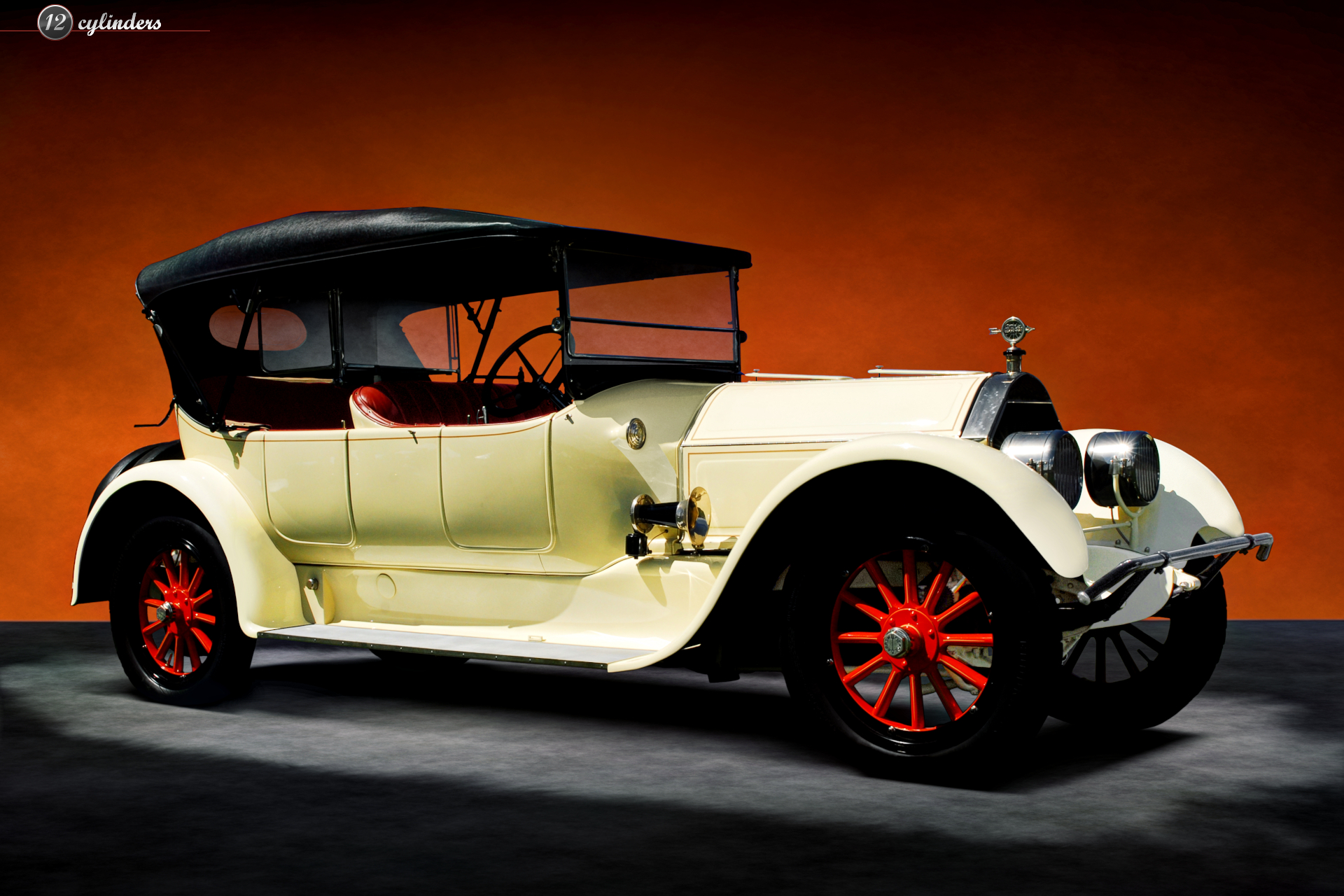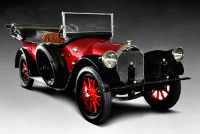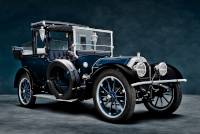Location:
Radnor Hunt Concours d'Elegance, 2012
Owner: David & Linda Baird | Coto de Caza, California
Prologue:
Note that the listing above cites the owner at the time of photography. The Baird family sought transfer through the Pierce-Arrow Society as of 2014, and later RM Sotheby's.
We first saw this Pierce-Arrow at Pebble Beach in 2009, and though I loved the sleek body and peachy livery, for some inexplicable reason I walked away to snap more exotic machinery. I knew afterward, leaving the opportunity on the field, this Pierce-Arrow would be one that got away. But a few years later, the car appeared over here on the east coast at Radnor Hunt. Though excited to see the Model 48 again, for some inexplicable reason I walked away with only one photograph. Not much improvement. With the advent of our Pierce-Arrow portfolio, and with only one shot on hand, I determined to edit up the best possible version. The tech is old and the image small, but the scale makes alterations easier. I balanced the undercarriage detail and front seat separately to bring out color and definition, and digitally re-tooled the body section by section. The result looks fresh, and quells my disappointment over twice not paying attention.
- - - - - - - - - -
► Image Source: Nikon D200 (10.2 MP)
References:
- Ralston, Marc. "Pierce-Arrow" A.S. Barnes & Co., Inc., San Diego, CA. 1980, page 87-88, 231
- Ralston, Marc. "Pierce-Arrow, The Golden Age" Jostens Publications, Clarksville, TE. 1984, page 118
- RM Sotheby's: The 2015 Santa Monica auction description provides good information.
- The Pierce-Arrow Society: Photo reference for a brief "The War Years" history.
- Wikipedia: George M. Cohan
The Pierce-Arrow Society depicts George M. Cohan's Model 48-C-4 on their online history pages, and at one point Marc Ralston, then the Pierce-Arrow Society's president, owned the car. Ralston penned the 1980 Pierce-Arrow volume that consolidates much of the factory's own information, as well as a 1984 pictorial that updates production information and vehicle identification. Along with Automobile Quarterly, our portfolio uses both sources to a great extent, so a Pierce-Arrow connected to the person behind the historical grunt work is significant in itself, the man who owned Broadway notwithstanding.
The owner who followed Marc Ralston, Dr. Gregory Johnson, conducted a full restoration in the 1980s based on the original configuration and livery. What we see here is the car as specified by Cohan from Pierce-Arrow, which is a treat.
George M. Cohan and the Pierce-Arrow Model 48
Purchased new by Cohan in the same creamy primrose and hot orange livery shown today, this Series 4 Model 48-C began its life with one of the most famous entertainers of the early 20th century. The Cohan name doesn't trip off contemporary tongues, (actually an Americanization of the Irish Keohane), but his bronze statue stands today in Times Square with the words, "Give my regards to Broadway" scripted on the pedestal. (Oscar Hammerstein is responsible for the statue.) NPR called Cohan, "an anthem machine," and his most popular songs lasted the century.
The oft-referenced Broadway epithet dates to his 1904 musical, "Little Johnny Jones," which I could not have told you before looking up the fact, (but I know the melody). Even my grade school classes sang, "You're a Grand Old Flag," and I still remember the chorus. In 1942, the year of Cohan's death, James Cagney played Cohan in the biopic "Yankee Doodle Dandy" and won the Academy Award for Best Actor. Cagney again played Cohan in the 1955 film, "The Seven Little Foys." Born to a vaudeville family in 1878, George Cohan forms the bedrock of American entertainment, with strong ties to the Broadway musical stage phenomenon. A Pierce-Arrow from Buffalo is therefore a perfect fit—natural like Clark Gable and his Duesenberg, Steve McQueen and his XKSS.
Another note related to George M. Cohan, RM Sotheby's write that, "There has long been an apocryphal story that the writing [of Cohan's famous song, "Over There"] took place in this car." Cohan wrote the song in 1917 after hearing of President Woodrow Wilson's declaration of war on Germany. However, the song's chronology does not match the car's registration date, so the story remains apocryphal.
Motor: 8,603.2 cc (525 cubic inch) straight 6-cylinder | 114.3 mm x 139.7 mm (4½" x 5½")
Valvetrain: T-head, dual-valve, dual ignition
Aspiration: single updraft carburetor
Power: 48 rated horsepower @ 1,800 rpm (actual 92 horsepower)
Drivetrain: 4-speed manual transmission, rear-wheel drive
Front Suspension: drop-forged I-beam axle, special heat-treated steel, with semi-elliptic leaf springs
Rear Suspension: live axle with three-quarter-elliptic leaf springs
Architecture: steel channel-section frame, cast aluminum body
Kerb Weight: 2,313.3 kg (5,100 lbs)
Wheelbase: 3,606.8 mm (142 inches)
Top Speed: 112.6 km.h (70 mph)
Etymology:
The Model 48 takes its designation from the rated horsepower (not actual) of its 6-cylinder motor. The '-4' identifies the car as part of Pierce-Arrow's Series 4 production, which spans December 1915 through August 1918, consisting of two main production runs during which the company built each model sequentially. In 1918, Pierce-Arrow produced a third, limited run of the 48-B. The extension of Series 4 explains how 1916 and 1917 cars might use the '-4' designation. The series nomenclature began with Series 1 in 1913 with the Model 38-C, (without a '-1' to indicate the series). The 'B' simply refers to the middle of three models—38-C, 48-B, and 66-A—and is largely superfluous.
Figures:
Pierce-Arrow produced 2,397 Model 48 Series 4 cars, the most of any model in any production series to date, which is not surprising given the length of Series 4 production. Of those, Cohan's car wears a sporting four-passenger touring body, and is peculiar for its dual windshield configuration. The paint, cabin, and fixtures are all restored to original specification.
Value:
In 2015, RM Sotheby's evaluated chassis #15568 at $300,000 to $400,000.
Slim Skiff: Sporting Design and the Pierce-Arrow Touring Car
Third and fourth series Pierce-Arrow cars appear lower and leaner than their predecessors thanks to a three-inch frame drop. Running gear flows closely over large wheels and tyres, which lends an imposing stance similar to what Oldsmobile achieved a decade earlier with the impressive Limited Touring. These touring cars established a fast passenger transport trend, which continues to the Model 31 and 51 in subsequent years. Sportiness is more readily evident on diminutive cars such as this four-passenger configuration.
Not flat, fenders curve to fit the crown of tyres within the front wheel arches, and the depth of the headlamps creates a crouching, spider-like approach. Body lines bend gently from the curved bulkhead, up around the front row bench, and also around the tail. The body is smooth, without external door handles, the pinstripe unbroken along the shoulder. Pierce-Arrow never attempted the outrageous in its halcyon days, but paid close attention to the smoothness of line and harmony of shape. The cast aluminum body is streamlined by small degrees, a deliberate but also subtle process that advanced year after year, and may have even peaked in the late teens before the austerity of the 1920s brought harder shapes to more production-ready chassis.
Original Equipment: Features Specific to the George M. Cohan Pierce-Arrow
The reader will like to know that George Cohan's Pierce-Arrow came equipped with tethers on the underside of the hood to keep occupant hats from escaping in the wind. A formidable car, the Model 48-B is perhaps the sweet spot in Pierce-Arrow's line during the teens, and with a touring body would have been one of the fastest automobiles on the road. Also intriguing is the rear windscreen, a complete unit with broad wind wings very much like contemporary European skiff designs, or the dual-cowl phaeton configuration (but without the second cowl). Also of note, Ron Kimball photographed this car more recently. His photos show a set of seat covers, which if not the originals themselves, were part of the original equipment.
Drum and Stanchion: The Story of Pierce-Arrow New York Lights
Cohan's Pierce-Arrow eschews the optional integrated headlamp so popular among customers. Somewhat ironic, sources cite New York state regulations that restricted headlamp height, which would mean a resident would be more likely to opt for conventional headlamps instead of Buffalo's own innovation. Whether a verified influence, we see conventional light bars on Cohan's 1917 Model 48-B-4 and Campbell's 1915 Model 38-C-3. Both are New York cars and support the story behind the term, "New York lights." Except in this case there is nothing special about New York lights. The term just means normal lights, which are rather un-exceptional compared to the integrated headlamps developed at the Pierce-Arrow factory. In any case, the lamps on this car are true drums, large tubs that look like small spotlights on their stanchions.
Last Updated: Mar 26, 2025



